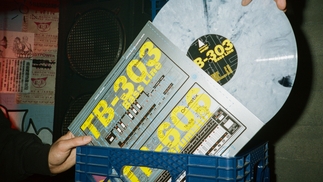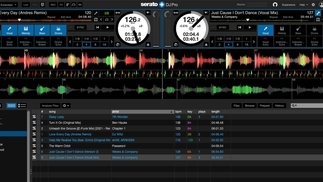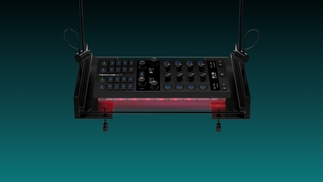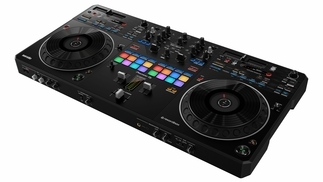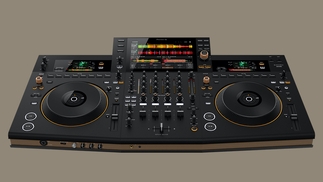TECH REVIEW: VESTAX VCI-380
Vestax’s evolution in the VCI series takes the controller range to a whole new level...
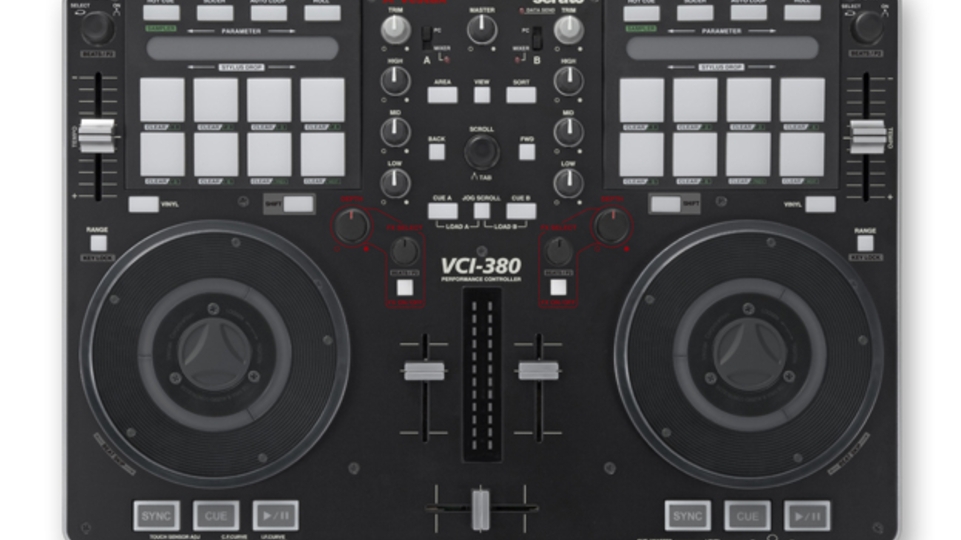
It is fair to say that Vestax were instrumental in kick-starting the whole controller movement back in the day with the VCI-100. Long before Native Instruments made the step up into hardware, Vestax were busy defining the blueprint for affordable, portable but hard-wearing DJ controllers that were something unique as opposed to a simulation of the classic ‘two-decks-and-a-mixer’ dynamic.
In that time the classic formula hasn’t changed a huge amount. The layout of the VCI-380 is very similar to the ubiquitous VCI-100, but with one key difference, the inclusion of eight velocity-sensitive performance pads over each deck section.

PAD TIME
The pad function offers DJs the chance to get really jiggy in the mix and is selected by the four buttons at the top of the device, dictating whether they control the hot cues, loops, rolls or slicer functions in the supplied Serato Itch software (DJs will soon be able to upgrade to the new Serato DJ software). When enabled, each setting changes the colour of the pads accordingly — resulting in a very clear indicator of which mode is active.
We won’t bore the readers with the finer details of what hot cues and loops do, it’s pretty much standard fare in any digital DJing software, and the roll function is almost universal in DJ controllers these days. Needless to say, the pads are super responsive and do their thing very well. The real talking point, however, is the slicer function.
SLICE & DICE
When enabled, the slicer mode allows for genuine realisation of one of the most overused and hyperbolic DJ claims out there; ‘the ability to remix live’. Essentially, it transforms the playing track into a triggerable step sequencer, cutting a live and constantly moving loop into eight slices that can be re-triggered or stuttered by using the pads, which illuminate in time as each step passes.
Creative possibilities in this mode are truly endless, but for the purpose of describing it, we will keep it simple. DJs could, for instance, create their own drum rolls by retriggering the kick, or create fills by stuttering a clap and snare slices. It is worth noting that this will only work with tracks that have a beat grid set on them using the DDJ software. So DJs will need to analyse their tracks for this to work. This is a very cool feature, and one that sets the device apart from what has come before it.
Another great feature of the performance pads is the ability to assign an effect to them, which is then controlled by the velocity, or how hard users hit the pad. For instance, combine the roll function (stuttering a portion of the track) with a high-pass filter to create the often heard resonance-drenched build-up-type effect. The dedicated controllerists amongst the crowd will certainly want to go beyond this and combine the pad effects with the effect banks that are available on each channel, allowing for another layer of creativity.

FX CITY
Speaking of the native effects, these are triggered using the small button above the channel upfaders, which some might find in a slightly cluttered and unhelpful position. However, in a device of this size it is perhaps inevitable.
With the shift button enabled the rotary immediately above the upfader acts to select which effect is to be used, and to modulate or set the timing of the designated effect. In another small and rather personal gripe, this is an encoder (infinite rotary knob), but has a rather unhelpful position marker on it, which serves no purpose and will annoy any OCD-inclined DJs (such as this one) who don’t want to see rotaries pointing in different directions for no apparent reason.
PLATTER
There is a platter on each side of the device that can be used in pitch-bend or vinyl mode — standard CDJ-style operation. On top of the platters there is a rotating LED which simulates the turning of the deck. It would be nice for this to change colour depending on which mode the platter is in. On a device with so many smart LED colour changes, this seems like an oversight and can result in some clangers if DJs accidentally have the wrong mode enabled.
The platters can be loosened or tightened depending on personal preference and DJing style by rotating the central axel on top of the deck. This is a nice, space-saving alternative to having a separate rotary and the range is extreme, resulting in a platter weight to suit even the most disparate styles.
ANALOGUE
Despite the excellent features in the performance pads, the biggest feature on the VCI-380 and the one that will set it apart from the rest of the range, is the fact that it is a full functioning hardware mixer and not just a controller.
This means users can run CDJs or turntables through it, and could even, with the use of an additional soundcard, use the device with timecode vinyl, thus creating a fully featured hardware mixer, leaving the platters to be re-assigned for creative effects work within the DVS software.
This is a huge coup for Vestax, and will be a massive selling point for the 380. Even pure laptop DJs and beginners will thrive on the idea that they have the option to expand their set-up with time or integrate it with hardware set-ups at house parties or clubs.
Needless to say, with the established Vestax quality and wealth of additional features, these will fly off the shelves. For those interested in controllerism, but with the option to have an expandable set-up, the VCI-380 needs to be on the radar.
|
VERDICT |
|
| Build quality | 8.0 |
| Ease of use | 8.0 |
| Features | 9.5 |
| Value for money | 8.0 |
| Sound Quality | 7.5 |
|
HYPE The perfect marriage of a DJ controller and mixer. |
|
| GRIPE A few small design quirks and slightly cluttered layout. |
|
|
A certain hit from the controller pioneers, demonstrating why they are so well-loved. |
|
| 8.5/10 | |
